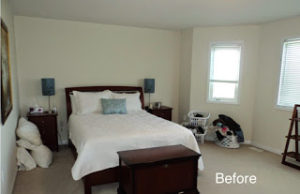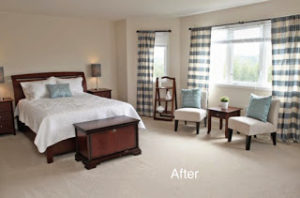
Top 10 Home Staging Myths
What exactly is home staging? Which houses should be staged? How do you know if it’s the right move for a house? If you’ve seen home staging featured on all of the great real estate television shows, you’re probably thinking that all home staging projects are expensive, and intended only for high-end homes, or homes that are in a serious need of decluttering. But you would be WRONG! Home Staging actually refers to the entire process of preparing a home for sale, ANY home for sale, and professional home stagers are working with every type of homeowner every day. Here we dispel the top 10 myths about Home Staging:
1. Home Staging is Expensive
Absolutely not! A trained professional stager is skilled at maximizing their client’s budget, whatever it is. When preparing a home for sale, it’s likely that the homeowners will need to plan to spend some money to get it to move-in ready, but with the recommendations of a professional home stager, often the largest investment is their time. Accessory packages and other staging packages vary by stager, but all home staging projects will generally start with a full-home evaluation, providing a list of recommendations for preparing the home.
Did you know? Buyers are actively looking for a move-in ready home, and 63% of home buyers are willing to pay more for this!
2. A home stagers job is to remove everything in a home and replace with new stuff
A professional home stager will not recommend adding or removing anything unless they believe that it will contribute positively towards the sale of the house, and they will do their best to work with a homeowner’s items, wherever possible, to achieve the desired results. Often, a little re-arranging of what they already have can work wonders for improving the flow, and overall appeal of a house to potential buyers! The truth is, sometimes it’s just not in the budget to invest in a large staging package.
3. All rooms should be painted builder’s beige
When selling a home, neutrals tones are best for showing off the space, but your typical “builder’s beige” is not recommended. In fact, today’s buyers are drawn to grey tones more than browns, giving the home a more modern look and feel. Whatever you choose, ensure that you select a neutral shade, and avoid colours that are too light. By choosing a colour a little further down the colour chip you’ll add warmth and a cozy, welcoming feel to a room.
4. Home staging is only for vacant homes or homes with ugly carpet and wallpaper
Certainly some homes can use updating more than others, but the truth is that every home can benefit from home staging, and often a few subtle changes can make a significant difference, whether it’s simply re-arranging some furniture, or more dramatic updates and repairs, every home is unique and requires a unique home staging plan. Vacant homes can tend to sit on the market longer than occupied and furnished homes, since with these properties buyers will struggle to make the necessary emotional connection to the home, and the same can be true for occupied homes that are not styled to suit the target buyer market. Home staging will help to improve the overall flow of the home, and provide the final touches that buyers will be drawn to.
5. Home staging is a way to fool buyers
Absolutely not! In fact, it’s the complete opposite! Our goal is to provide buyers with the home that they are looking for. Homeowners are still required to disclose any major flaws of the home that they are aware of, however home staging will help to minimize minor flaws by drawing the focus to the features of the home.
6. Home Staging is just removing personal photos and de-cluttering
We all know that we need to declutter and remove personal items from a home before listing, but home staging helps to address so much more. A professional home stager will help to create a style plan for your home, and address where to invest your money in repairs and updates. Home staging focuses on maximizing a home’s space, lighting, flow, design and best features, not just decorating the space.
7. It’s best to list a property first, and address home staging when it doesn’t sell
Home staging should always, always, always be considered BEFORE listing the home for sale! Cliché as it may sound, you really do only get one chance to make a first impression. When a home is listed, it should be ready to show at it’s best, both in pictures and for showings. Any Realtor® will tell you that you get the most attention for a property listing during the first couple of weeks that it is listed – these are key buyers! Home Staging is an investment with proven results for selling a home in less time, and for the most amount of money possible.
8. Staging is just the latest real estate trend
Home Staging has actually been around since the 1970s, and is a real estate service that is as common today as home inspections! Showing buyers that the home offers good value is always in style.
9. Buyers should be able to see past the updates that are needed and the homeowner’s “stuff”
Here’s a fun fact for you – only 10% of buyers have the ability to visualize a space! This means that only 1 in every 10 people that view a home will be able to look past things, and see the home’s true potential. If you’re considering a career in home staging, you clearly fall within the 10%, which means that you can help 90% of potential buyers to see a home’s true value! Show them the best way to live in the home by showing optimal furniture placement, and eliminating anything that might distract them from seeing the features of the home.
10. Home Staging means living in a show home, and that’s just not realistic to expect clients to do
A professional home stager provides options and solutions to allow their clients to maintain the function that they need while the home is listed. It’s not easy to live in a show home, but by providing the right recommendations for preparing their home, they won’t have to do so for long! As their home stager, you will help to provide them with tips and creative solutions for the things they need every day.
Have questions about becoming a Home Stager, or just starting out and need an extra boost in your business? Join our Facebook group, To Be a Home Stager – our very own Shauna Lynn Simon is live online every Thursday afternoon, answering your most pressing questions!






